What does land to land convergnt boundaries cause?
On This Page Navigation
Introduction
Sometimes an entire sea closes as tectonic plates converge, causing blocks of thick continental crust to collide. A collisional mount range forms every bit the crust is compressed, crumpled, and thickened fifty-fifty more. The effect is like a swimmer putting a beach ball under his or her belly—the swimmer will rise upwards considerably out of the water. The highest mountains on Earth today, the Himalayas, are so high because the full thickness of the Indian subcontinent is shoving beneath Asia.
The Appalachian Mountains formed during a collision of continents 500 to 300 million years ago. In their prime they probably had peaks every bit loftier as those in the modernistic zone of continental collision stretching from the Himalayas in Asia to the Alps in Europe. Only over the past 300 million years, the Appalachians have eroded to more pocket-size heights.
Collisional Mountain Range Development



Modified from "Parks and Plates: The Geology of our National Parks, Monuments and Seashores," by Robert J. Lillie, New York, Westward. West. Norton and Company, 298 pp., 2005, www.amazon.com/dp/0134905172.
NPS Sites in Collisional Mountain Ranges
The Appalachian Mountains extend from the Maritime Provinces of Canada all the way to northern Georgia and Alabama. The continental collision zone extends fifty-fifty farther southwestward, but immature sediments of the Gulf coastal obviously cover nearly of information technology. It does surface as the Ouachita Mountains of western Arkansas and southeastern Oklahoma, and the Marathon Mountains of due west Texas. The Brooks Range is another, younger zone of continental collision, stretching beyond northern Alaska.
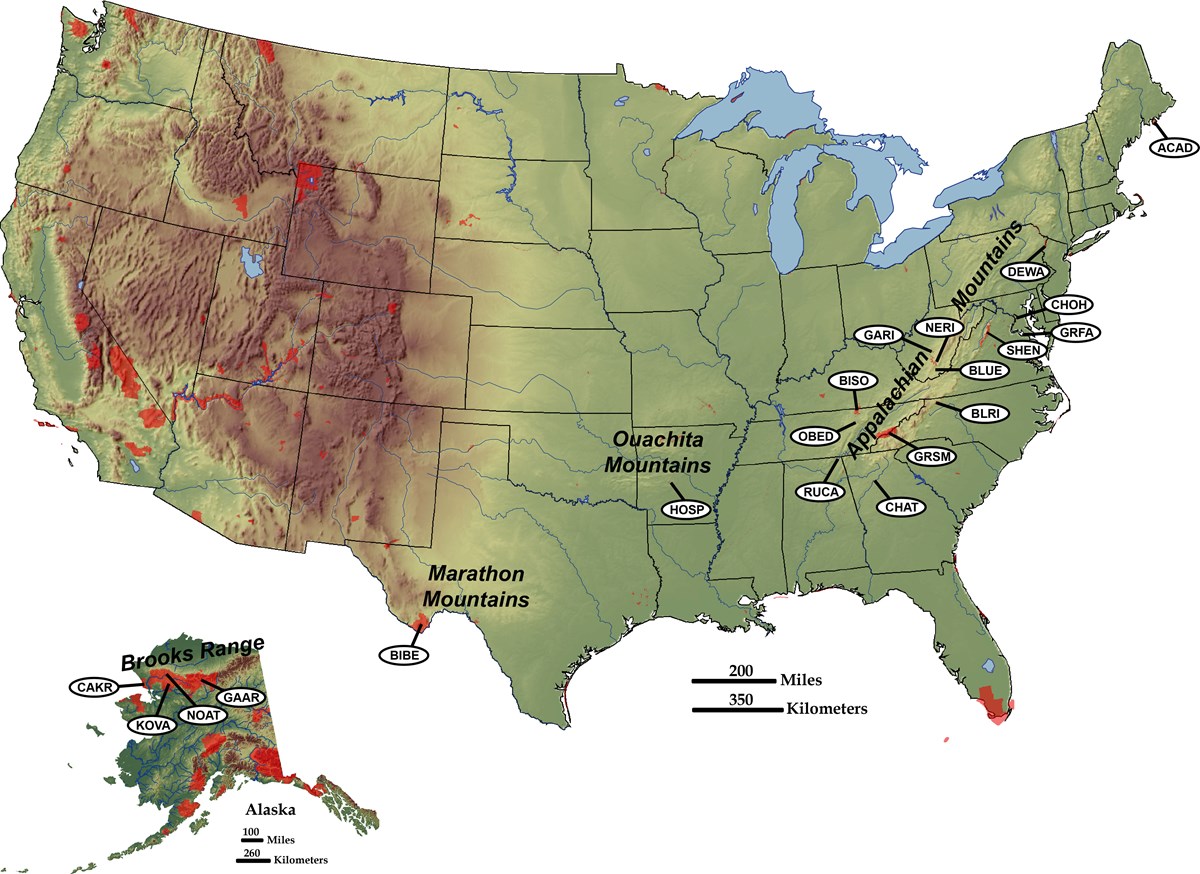
Modified from "Parks and Plates: The Geology of our National Parks, Monuments and Seashores," by Robert J. Lillie, New York, W. W. Norton and Company, 298 pp., 2005, www.amazon.com/dp/0134905172.
Appalachain / Ouachita / Marathon
Appalachain Mountains [12 parks]
-
ACAD—Acadia National Park, Maine—[Geodiversity Atlas] [Park Home]
-
BISO—Big Southward Fork National River and Recreation Expanse, Due north Carolina & Tennessee—[Geodiversity Atlas] [Park Home]
-
BLRI—Blue Ridge Parkway, Virginia & Due north Carolina—[Geodiversity Atlas] [Park Home]
- BLUE—Bluestone National Scenic River, Due west Virginia—[Geodiversity Atlas] [Park Domicile]
- Chat—Chattahoochee River National Recreation Area, Georgia—[Geodiversity Atlas] [Park Home]
- DEWA—Delaware H2o Gap National Recreation Area, Pennsylvania—[Geodiversity Atlas] [Park Home]
-
GARI—Gauley River National Recreation Area, West Virginia—[Geodiversity Atlas] [Park Home]
- GRSM—Bang-up Smoky Mountains National Park, North Carolina & Tennessee—[Geodiversity Atlas] [Park Habitation]
- NERI—New River Gorge National River, West Virginia—[Geodiversity Atlas] [Park Home]
-
OBED—Obed Wild and Scenic River, Tennessee—[Geodiversity Atlas] [Park Domicile]
-
RUCA—Russell Cave National Monument, Alabama—[Geodiversity Atlas] [Park Home]
-
SHEN—Shenandoah National Park, Virginia—[Geodiversity Atlas] [Park Home]
Northern Alaska
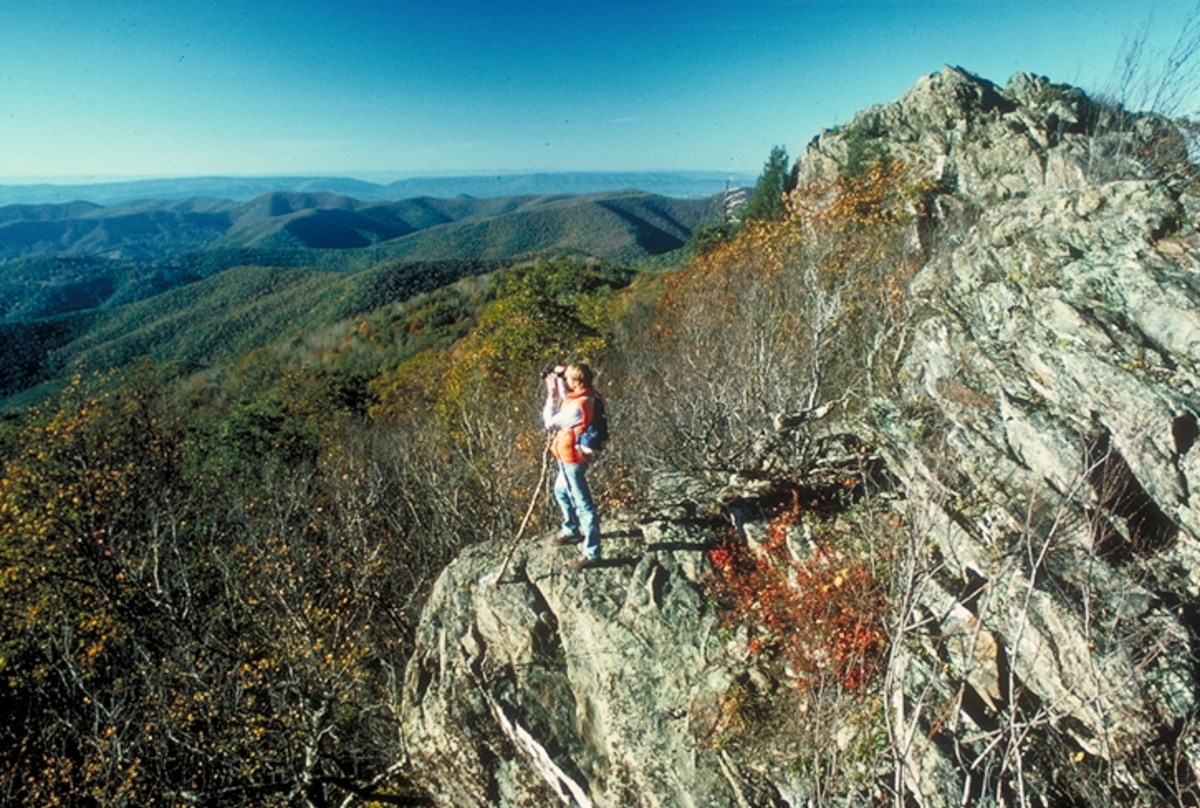
NPS photo.
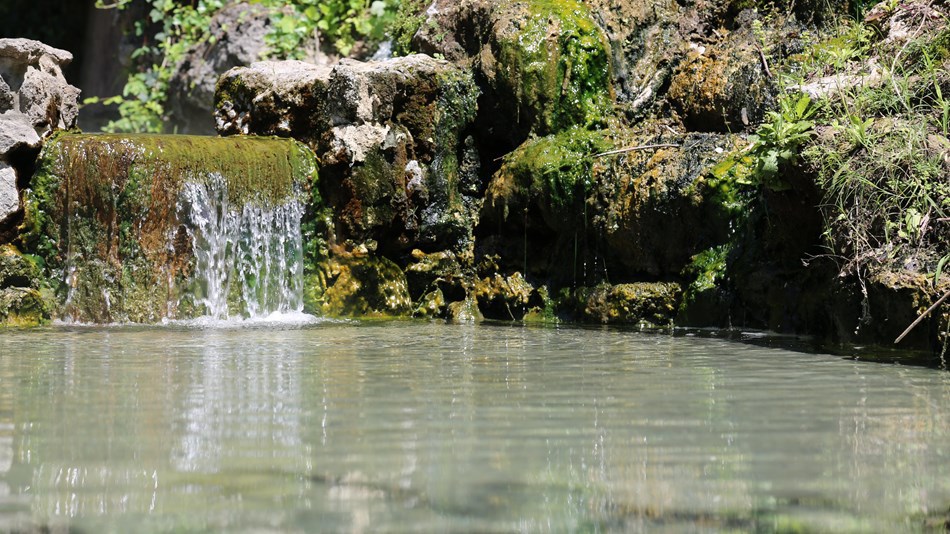
NPS photo.
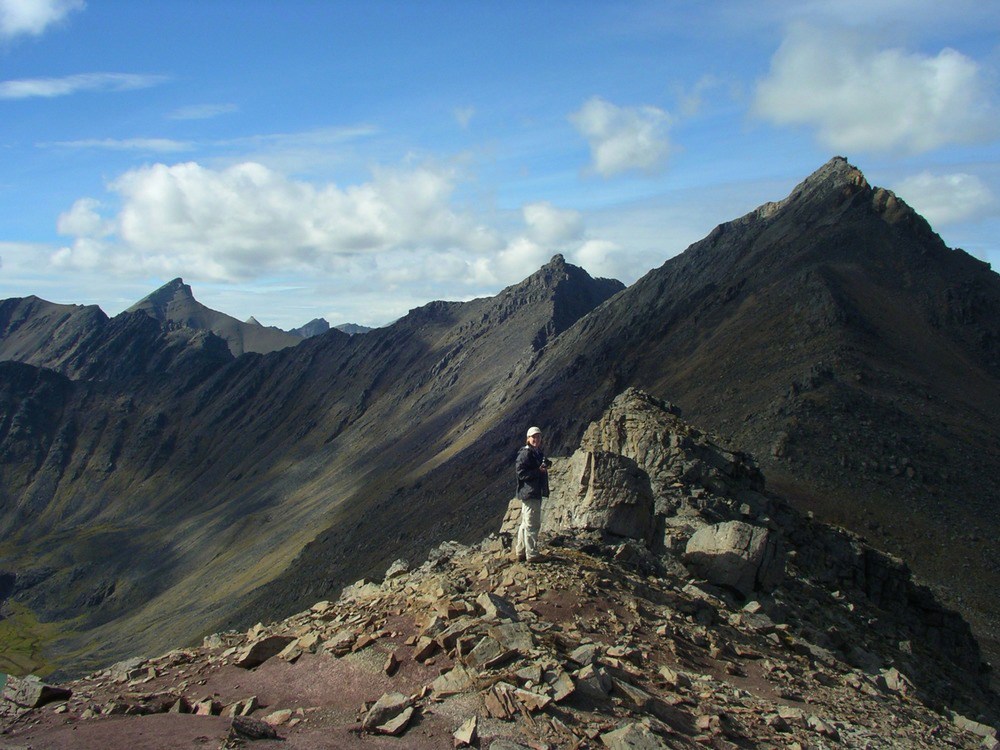
NPS photo.
Appalachian–Ouachita–Marathon Continental Standoff Zone
Several National Park Service sites are in the mountains that prevarication inland from the Atlantic and Gulf coasts of the United States. A visit to i of those sites reveals non only beautiful mount scenery, just also rocks and topography that tell a story of aboriginal episodes of globe-trotting plates and crashing continents.
NPS Sites in Appalachian-Ouachita-Marathon Collisional Mountain Range
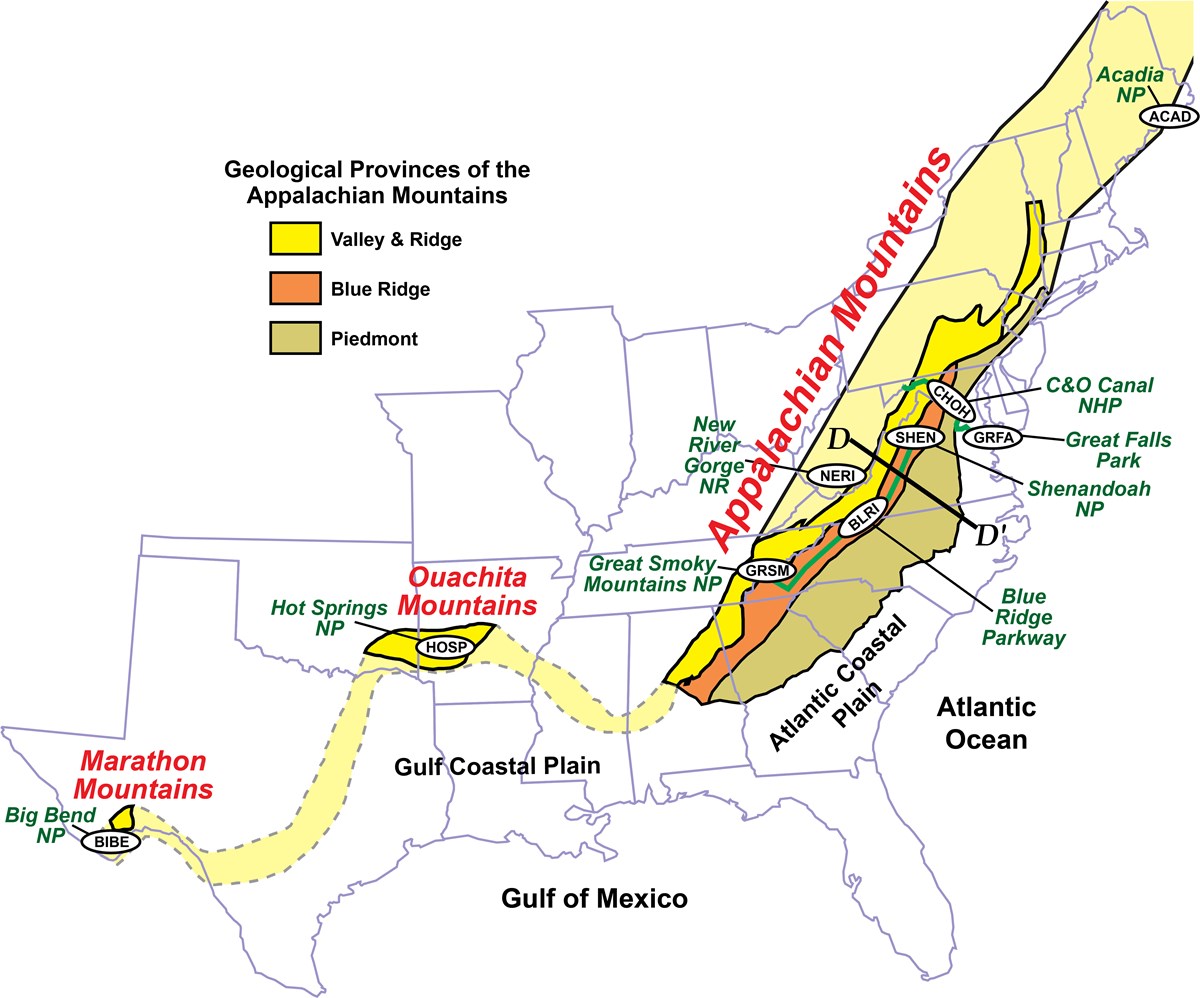
Modified from "Parks and Plates: The Geology of our National Parks, Monuments and Seashores," by Robert J. Lillie, New York, W. Due west. Norton and Company, 298 pp., 2005, www.amazon.com/dp/0134905172.
The Appalachian Mountains are part of a collisional mountain range that includes the Ouachita Mountains of Arkansas and Oklahoma, and the Marathon Mountains in w Texas. After 300 one thousand thousand years the mountains have eroded deeply and are covered in places past immature sediments of the Atlantic and Gulf coastal plains. Four-letter of the alphabet codes refer to some of the National Park Service sites listed near the top of this page. The Blueish Ridge Parkway follows the crest of the mountains in Virginia and North Carolina, connecting Shenandoah and Great Smoky Mountains national parks. Hot Springs National Park is in the Ouachita Mountains, while the Marathon Mountains extend into Big Curve National Park. Acadia National Park is in the northern Appalachians in Maine. D-D' is the line of the cross section showing in the tectonic provinces of the Appalachian Mountains.
Tectonic Evolution of the Appalachian—Ouachita—Marathon Mountain Range
The Appalachian Mountains, along with the Caledonide Mountains in Greenland, the British Isles and Scandinavia, as well as the Atlas Mountains in northeastern Africa, are parts of a continental collision zone that formed 500 to 300 one thousand thousand years agone. Later rifting opened the Atlantic Body of water, isolating the mountains as separate ranges on dissimilar continents.
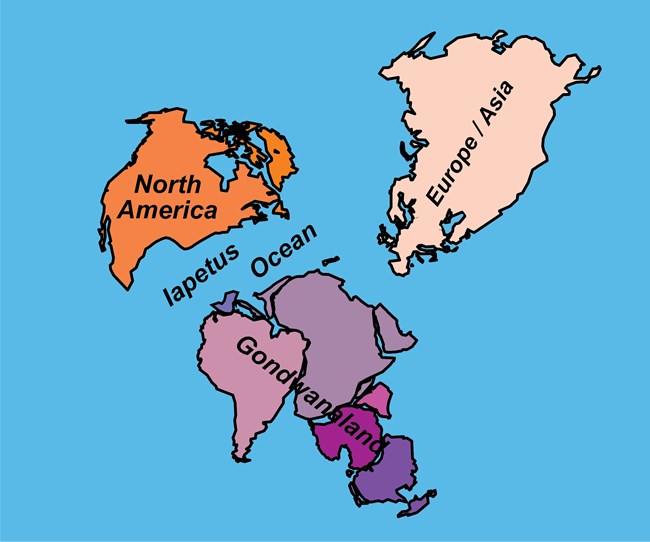
500 Million Years Ago
. Land that will afterward become Florida is part of Africa. The Yucatan Peninsula and Republic of cuba may take been on the n side of South America.
Modified from "Parks and Plates: The Geology of our National Parks, Monuments and Seashores," past Robert J. Lillie, New York, W. W. Norton and Company, 298 pp., 2005, www.amazon.com/dp/0134905172.
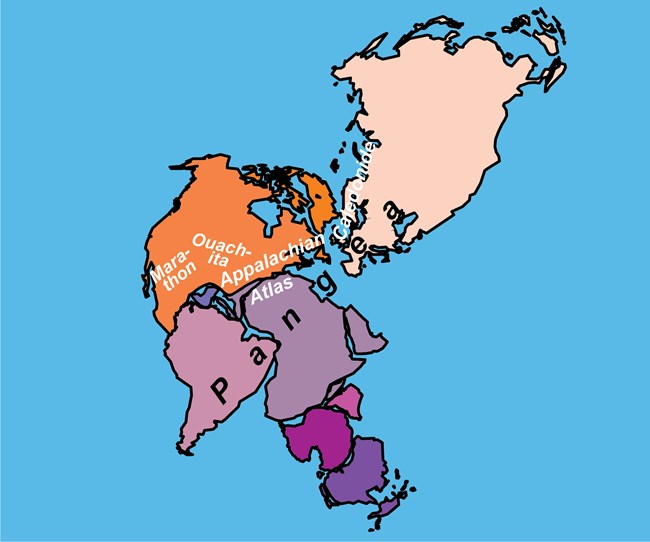
250 Million Years Ago
Iapetus Ocean Closes. Pangea forms equally the continents collide. The Appalachians are function of a larger zone of continental standoff that includes the Marathon and Ouachita mountains in the southern United States, the Atlas Mountains in Africa, and the Caledonide Mountains in Greenland, the British Isles, and Scandinavia.
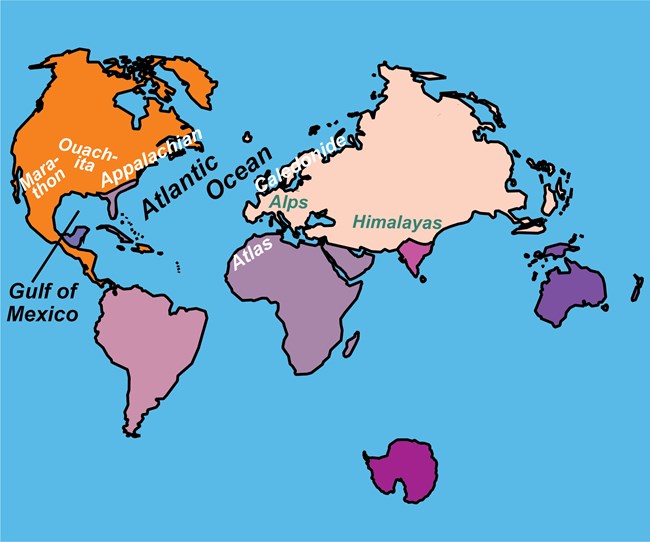
"Today"
Atlantic Ocean and Gulf of United mexican states Open. The modern oceans originated well-nigh 200 million years agone when Europe, Africa and South America ripped away from N America. Fragments of the collision zone mountains were left on three continents: the Appalachians in Northward America, the Atlas in Africa, and the Caledonides in Europe. The Atlantic continues to widen along the Mid-Atlantic Ridge. The Gulf of Mexico ceased opening about 100 million years ago, when tectonic activity shifted eastward to the Caribbean area region. Continental collision is occurring today where Africa and Republic of india ram into Europe and Asia, forming the Alpine-Himalayan chain.
Endmost the Iapetus Ocean
The continents of Africa, S America, Australia and Antarctica were originally part of a large supercontinent called Gondwanaland. Prior to 500 million years agone, the ancient North American continent was separated from Gondwanaland and Eurasia by a big body of water known as the Iapetus Ocean. As the Iapetus Ocean closed forth subduction zones, various volcanic islands and continental fragments (terranes) collided with the continental edges and became permanently attached (accreted). Somewhen, the entire Iapetus Bounding main airtight and the continents collided to form the supercontinent of Pangea.
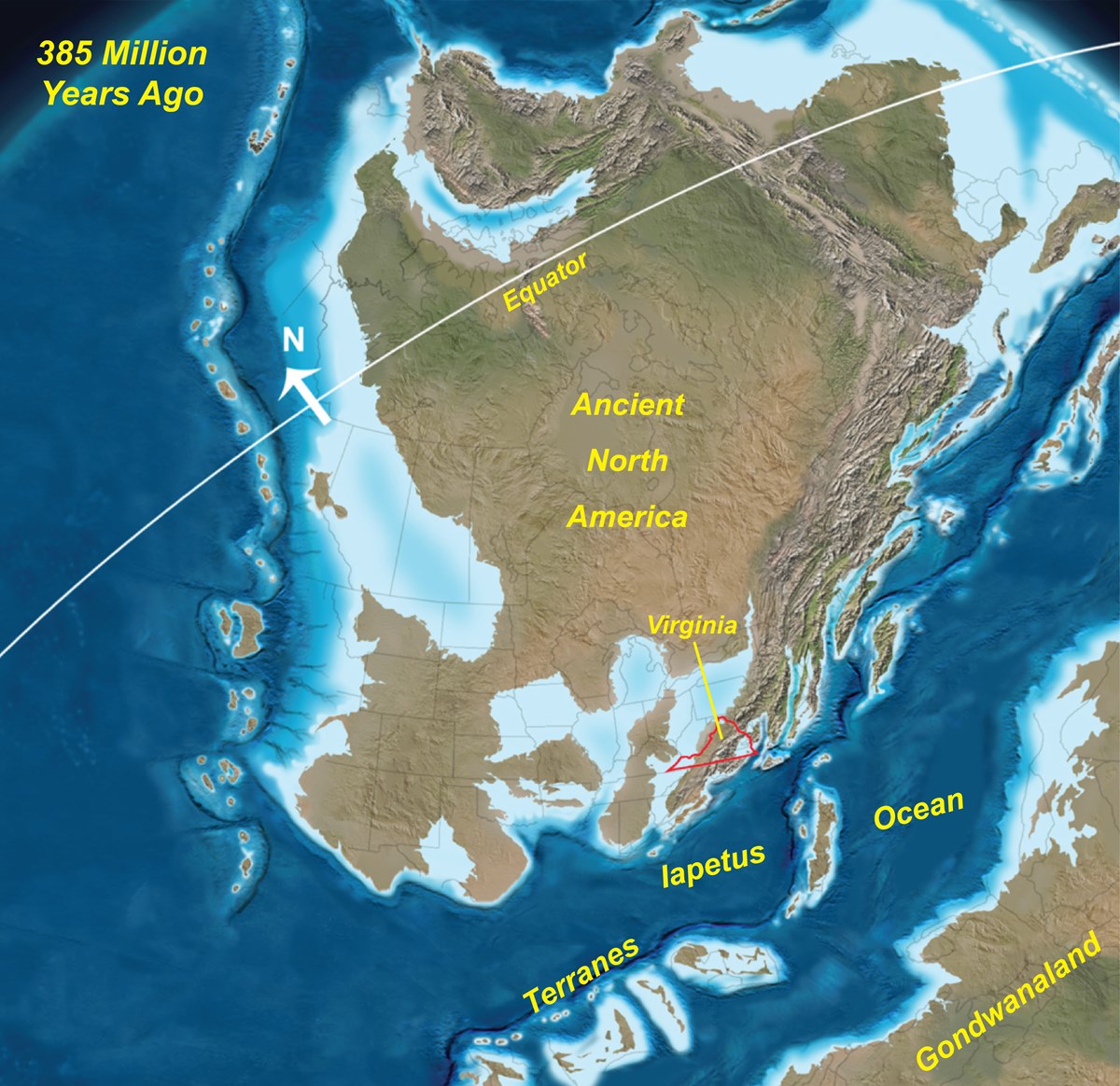
Paleogeographic map from Ron Blakey, Northern Arizona Academy, http://cpgeosystems.com/paleomaps.html
Appalachian Mountains
The tectonic history of the Appalachian Mountains involves opening an ancient ocean along a divergent plate boundary, closing the sea during plate convergence, and and so more divergence that opened the Atlantic Ocean. Tracing this large-scale evolution helps us understand the place of origin of the diverse geologic provinces of the Southern Appalachian Mountains, as well equally the rocks and structures observed along the Blue Ridge Parkway, the C&O Canal National Historical Park, and other NPS sites in the region.
Tectonic Evolution of the Southern Appalachian Mountains
750 Meg Years Ago
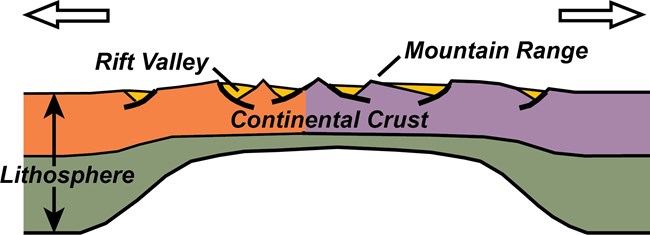
. The long mountain ranges and rift valleys were similar to those forming today in East Africa and the Basin and Range Province.
500 Million Years Ago

Iapetus Ocean Opens. Continental blocks destined to become North America and Gondwanaland migrate apart. The eastern edge of ancient Northward America developed into a passive continental margin, similar to the modern East Coast. As the margin cooled and subsided, thick sedimentary strata covered the before mountains and rift valleys.
400 Million Years Agone

Iapetus Ocean Narrows during Subduction. Oceanic sediments and volcanic islands were at times added to the border of North America.
300 Million Years Ago
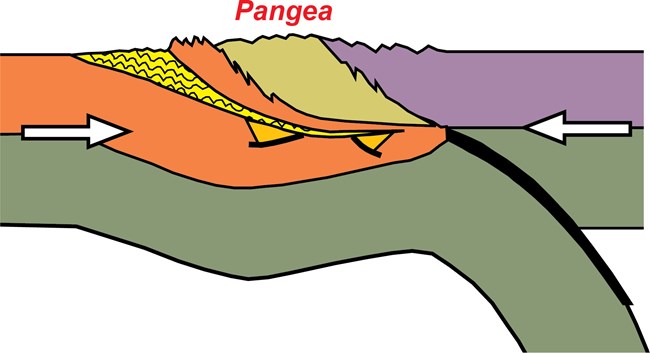
Iapetus Body of water Completely Closes. The Southern Appalachians develop as the African portion of Gondwanaland crashes in, forming the supercontinent of Pangea.
Today

Atlantic Ocean Opens
. Aboriginal ocean rocks are left backside as the Piedmont Province, along with a sliver of Africa that now lies below the Coastal Plain of Florida and offshore regions of Georgia and the Carolinas (purple). The Blue Ridge Province is part of North America's ancient continental margin, while the Valley and Ridge Province contains sedimentary layers of Northward America that were folded and faulted during the collision.
illustrations above modified from "Parks and Plates: The Geology of our National Parks, Monuments and Seashores," by Robert J. Lillie, New York, West. W. Norton and Company, 298 pp., 2005, www.amazon.com/dp/0134905172.
Virtually 750 million years ago a very ancient supercontinent began to rip autonomously. The resulting continental rift zone was much like today's Basin and Range Province, with long mountain ranges separated by downward-dropped valleys. Sedimentary and volcanic layers that were deposited in the rift valleys are exposed in Shenandoah National Park and along the Blue Ridge Parkway. As the ocean widened, the border of ancient North America subsided, and a blanket of sedimentary layers buried the rift valleys and eroded mountain ranges. Examples of these aboriginal passive continental margin layers are found today along the Blue Ridge Parkway and in Great Smoky Mountains National Park.
From virtually 400 to 300 one thousand thousand years agone the Iapetus Sea gradually closed during subduction. In the process volcanic islands, continental fragments and the supercontinent of Gondwanaland collided with the ancient continental margin of Northward America. In the western office of the Appalachian Mountains, the rocks were originally office of Northward America. The Valley and Ridge Province is folded and faulted sedimentary strata of the ancient continental margin, and the Blue Ridge Province is a piece of the deeper, hard crust that was uplifted and shoved westward. Farther east, the rocks formed elsewhere and were attached (accreted) to the border of Due north America equally the sea closed. The Piedmont Province is an array of accreted terranes, metamorphosed sedimentary layers and crust of the Iapetus Ocean that were caught up in the collision. In places the Atlantic Ocean opened some distance east of the zone of "suturing" between the continents. Rocks beneath young sediments on the Coastal Evidently of Florida and areas offshore from Georgia and the Carolinas are stranded pieces of Africa, left behind when the Atlantic opened.
Tectonic Provinces of the Southern Appalachian Mountains
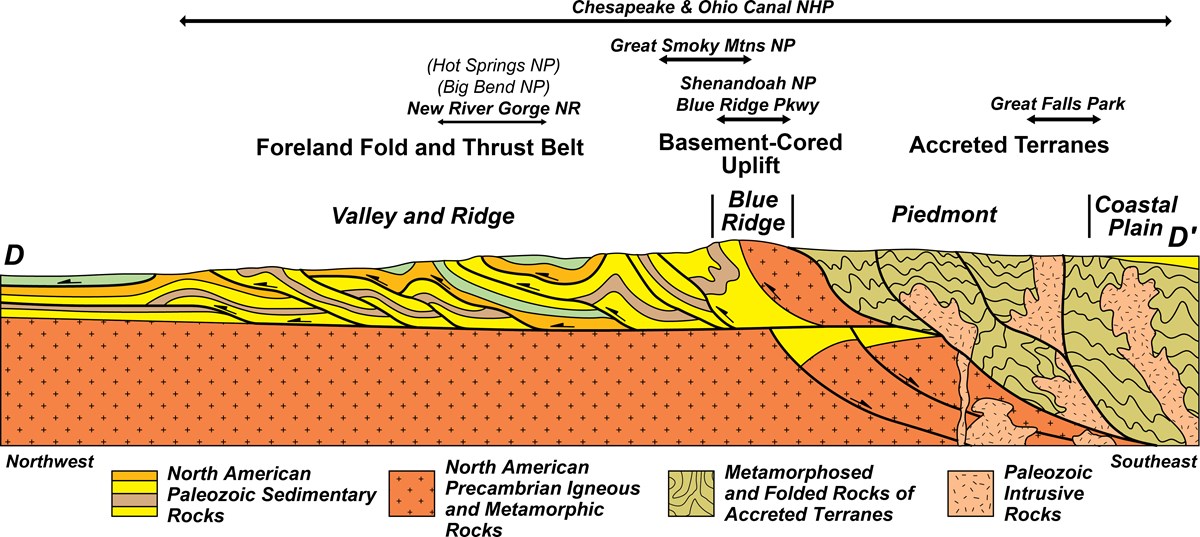
Modified from "Earth: Portrait of a Planet, past Southward. Marshak, 2001, Due west. W. Norton & Comp., New York.
National Park Service sites in the Appalachian Mountains take rocks and landscapes resulting from collision of North America with accreted terranes and the ancient continent of Gondwanaland.
- The Piedmont Province contains islands and continental fragments (accreted terranes) that were in the ancient Iapetus Ocean and were caught up in the collision between the continents.
- The Blue Ridge Province has hard igneous and metamorphic rocks that we uplifted along the edge of Due north America as the continents collided.
- The Valley and Ridge Province is composed of sedimentary layers of the ancient continental margin that were folded and faulted during the collision.
- The 184 mile long C&O Canal National Historical Park spans all of the tectonic provinces.
- Great Falls Park lies on the eastern edge of the Piedmont Province, while the Blue Ridge Parkway and Shenandoah National Park lie entirely within the Blue Ridge Province.
- Great Smoky Mountains National Park is mostly within the Bluish Ridge Province, with a portion extending into the Valley and Ridge Province.
- New River Gorge National River is in the Valley and Ridge Province.
- Elsewhere along the standoff zone, the Ouachita and Marathon mountains are foreland fold-and-thrust belts like to the Valley and Ridge Province, and include Hot Springs National Park in Arkansas and a small-scale function of Big Curve National Park in Texas.
The concluding events in the Appalachian story have been occurring over the past 250 million years, as Pangea ripped apart, the Atlantic Ocean opened, and the Appalachian Mountains have been wearing down by erosion. Sedimentary and volcanic strata are found in rift valleys in the eastern office of the Piedmont Province, relics of the rifting of Pangea about 200 million years ago. The Atlantic Coastal Obviously is covered past sedimentary layers of the modern passive continental margin.
The deeper yous go into the Earth the higher the temperature and pressure. Some of the rocks of the Appalachian Mountains were metamorphosed to such a degree that they must have been 5 to xv miles (10 to 25 kilometers) below the surface. The deep metamorphic rocks were brought back to the surface via 2 tectonic processes: thrust faulting and isostatic rebound. By the first procedure, the rocks were compressed and shoved (thrust) upwards along fault lines as the ocean closed and the continents collided. The second process (isostasy) results in the wholesale uplift of a wide region as the crust thickens. But as the weight of the high mountains is reduced by erosion, the thick, buoyant crust bobs back up (rebounds), creating topography not quite every bit high as it was before. As much every bit fifteen miles (25 kilometers) of rock has been removed since the Appalachians initially formed, exposing the metamorphic rocks.
Blue Ridge Parkway
National Park Service sites in the Appalachian Mountains offer an opportunity for visitors to experience the overall landscape and local geology of an ancient continental collision zone. The Blue Ridge Parkway stretches 469 miles (755 kilometers), from Shenandoah National Park on the northeast to Neat Smoky Mountains National Park on the southwest. Although those parklands are mostly confined to ane physiographic province, the Blue Ridge, their heights provide vistas of other parts of the standoff zone: the Valley and Ridge Province to the west and the Piedmont to the east. Outcroppings along road cuts and valley walls reveal deformed and uplifted rocks that formed along the edge of ancient Due north America. Some of those rocks were buried more than ten miles (15 kilometers) during the continental standoff, and so uplifted and exposed by a combination of thrust faulting, erosion, and isostatic rebound.
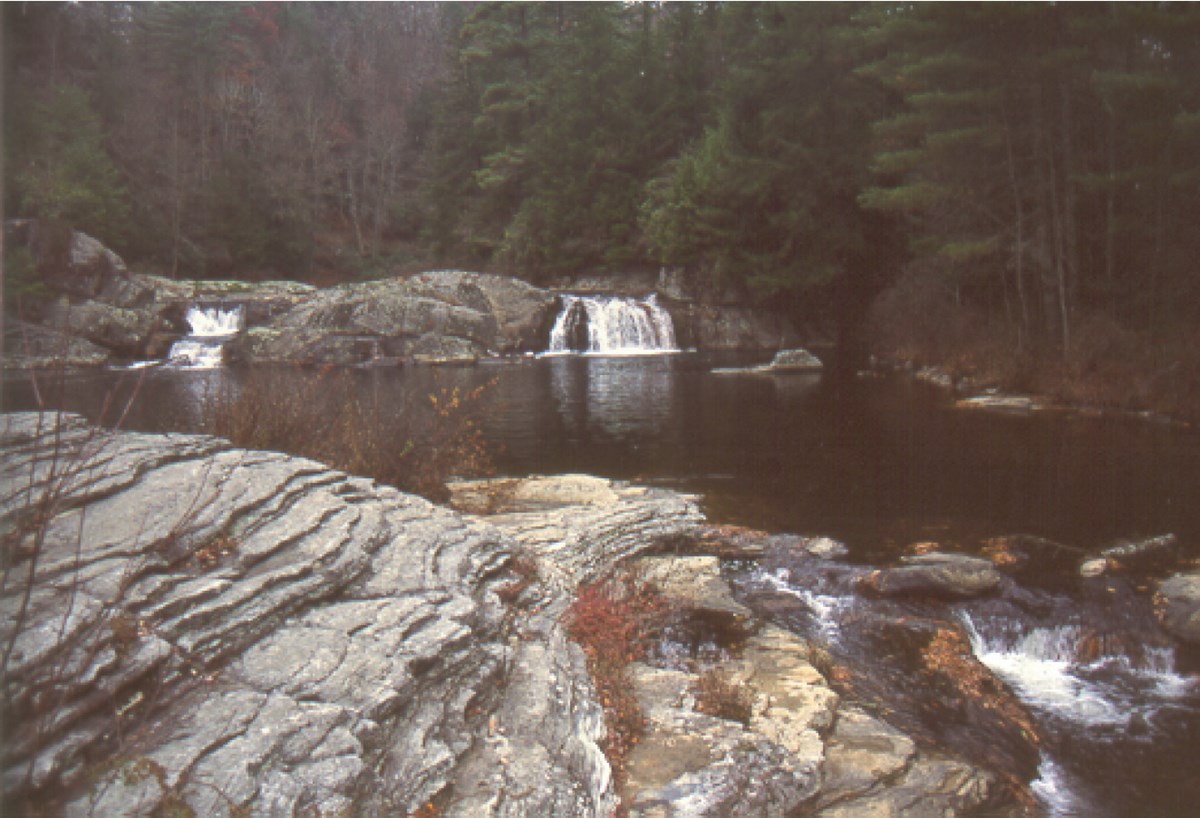
Blueish Ridge Parkway, Northward Carolina and Virginia. Linville Falls flows over 1.1 billion-year-old gneiss, a high-form metamorphic rock. The rock in the foreground is 550 1000000-year-old sandstone of the Chilhowee Formation, at present metamorphosed to quartzite. These rocks are office of the continental margin of ancient Due north America that was uplifted every bit part of the Blueish Ridge Province during the last phases of continental collision that formed the Appalachian Mountains. Photograph past Robert J. Lillie.
Great Smoky Mountains
Corking Smoky Mountains National Park is the most visited unit in the entire National Park Organisation, attracting more than 11 million people per twelvemonth. Afterward North Carolina's Mt. Mitchell, the park contains the highest peaks in the Appalachian Mountains, including Clingmans Dome (6,642 anxiety; 2,024 meters) and Mt. Guyot (6,621 feet; ii,018 meters). The spectacular scenery of the park lies within the Bluish Ridge Province, with a small portion on the northwest in the Valley and Ridge Province.
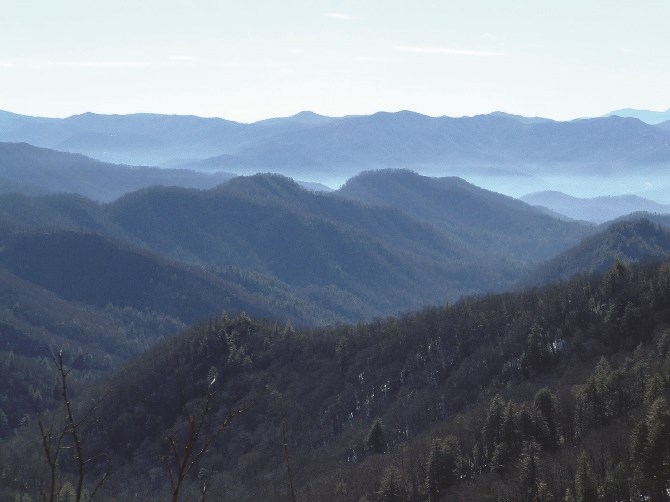
NPS photograph.
DC Expanse Parks
Parks in the Washington DC surface area reveal a lot about the geology and tectonic evolution of the Appalachian Mountains. The Chesapeake and Ohio (C and O) Canal National Historical Park runs for 185 miles (298 kilometers) from Cumberland, Maryland to Washington DC. It follows the valley that the Potomac River has carved across all of the Appalachian tectonic provinces, including the Valley and Ridge, Blue Ridge, Piedmont and Coastal Plain. About DC it parallels Great Falls Park in Virginia, where rapids course equally the Potomac River flows over the steep border of the difficult metamorphic rocks of the Piedmont Province to the softer sedimentary layers of the Atlantic Coastal Plainly.
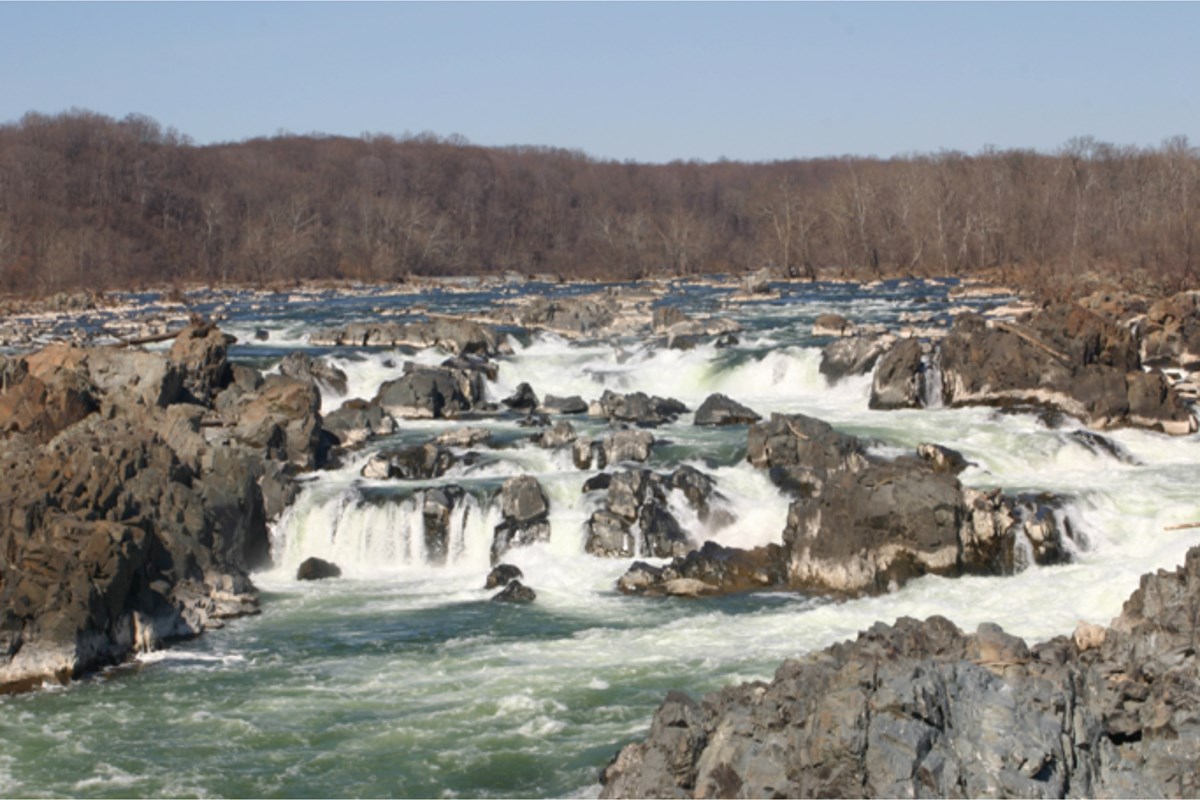
Photograph past Robert J. Lillie.
Ouachita Mountains
The Ouachita Mountains of western Arkansas and southeastern Oklahoma are a classic example of a soft continental collision. Plate convergence ceased soon afterward the ocean separating ancient Due north America from Gondwanaland closed. The crust beneath the growing mountains remained relatively thin. Peaks never attained heights anywhere nearly those of the modern Himalayas and Alps, nor of the ancient Appalachians. In their prime, Ouachita peaks probably rose to no more than the modest height (~ix,000 feet; 2,750 meters) of the Carpathian Mountains in central Europe. The low buoyancy of thin chaff immune the accumulation of thick sedimentary layers every bit the ancient ocean closed about 280 million years ago. Without thick crust and high mountains, in that location has been only modest amounts of erosion and isostatic rebound, and so that a pile of sedimentary layers equally much as 12 miles (20 kilometers) thick notwithstanding lies beneath the Ouachita Mountains.
Tectonic Evolution of the Ouachita Mountains
400 One thousand thousand Years Ago

280 One thousand thousand Years Agone

Soft Continental Collision. The Ouachita Mountains never grew very high considering continental collision stopped earlier the two thick continental crusts ever overlapped. A very thick pile of sediments was deposited and deformed to a higher place the relatively thin crust of the ancient passive continental margin.
Today

Illustrations above modified from "Parks and Plates: The Geology of our National Parks, Monuments and Seashores," by Robert J. Lillie, New York, W. Due west. Norton and Company, 298 pp., 2005, www.amazon.com/dp/0134905172.
Hot Springs National Park in Arkansas preserves evidence of the soft continental collision that formed the Ouachita Mountains. Rocks are non the difficult igneous and metamorphic multifariousness found in the Appalachian Mountains, but rather softer sedimentary layers scraped off the seafloor and thrust over the edge of the continent as the ocean between North and Due south America closed. The originally horizontal rocks are folded and faulted, much as the strata in the Valley and Ridge Province of the Appalachians.
Ouachita Mountains, Arkansas
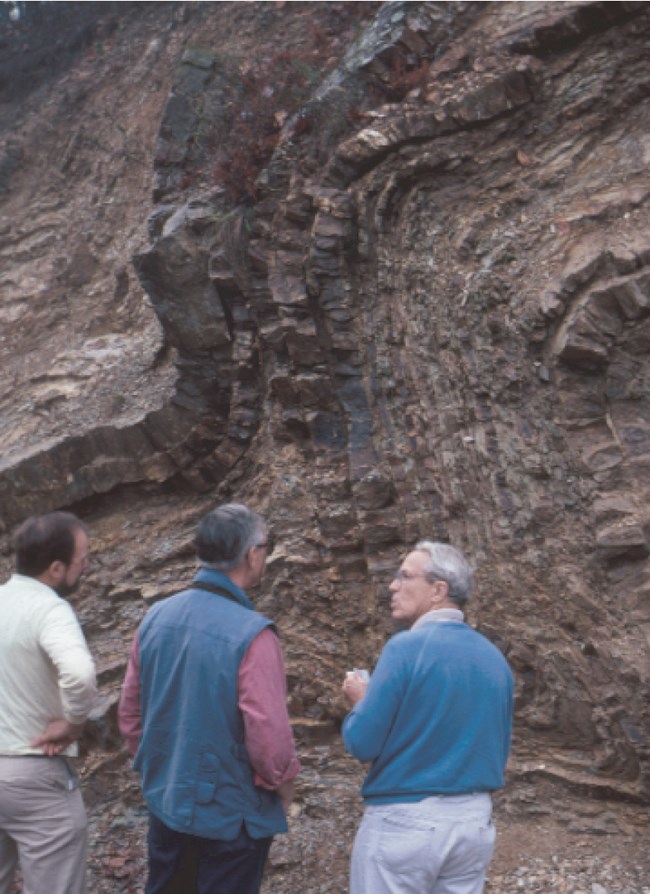
The sandstone, shale and chert layers are function of a thick pile of sediments that were deformed and uplifted equally Gondwanaland collided with the southern edge of ancient N America 280 million years ago.
Photograph courtesy of Robert J. Lillie.
Congress established Hot Springs National Reservation in 1832 to preserve and protect the region of thermal waters around Hot Springs Mountain in Arkansas. In its mission and administration, it might arguably be considered the first site operation as a "national park." The first formal national park, Yellowstone, was established by act of Congress twoscore years later. The thermal waters for which Hot Springs National Park is named are non due to the presence of shallow magma below the area, as at Yellowstone. Rather, the hot springs occur because there are cracks in chert layers outside the park that permit rainwater to circulate slowly downward, where it is heated due to the normal increase in temperature with depth in the Earth. More prominent systems of faults and cracks directly beneath the park allow the h2o to render dorsum to the surface much quicker, while information technology is yet about 140 °F (60 °C)—more enough for a refreshing, therapeutic soak!
Marathon Mountains
The surface area of southwest Texas where the Rio Grande River takes a sharp turn to the north displays the effects of three superimposed tectonic episodes. The latest is the ongoing continental rifting forming the Rio Grande Rift arm of the Basin and Range Province. Earlier pinch of the Due north American continent from 80 to 40 million years ago formed the Laramide Uplifts, which include the frontal ranges of the Rocky Mountains. And before that, the soft continental collision that formed the Ouachita Mountains 280 million years as well formed the Marathon Mountains. The northernmost part of Big Curve National Park, effectually Persimmon Gap, lies in the Marathon Mountains and includes rocks and structures similar to those institute in the Ouachitas. The park thus preserves the westernmost vestiges of the oceanic closure and continental collision found not but in the Appalachians of the U. S. and Canada, only also in widely-separated regions of Africa and northern Europe.
Big Bend National Park, Texas
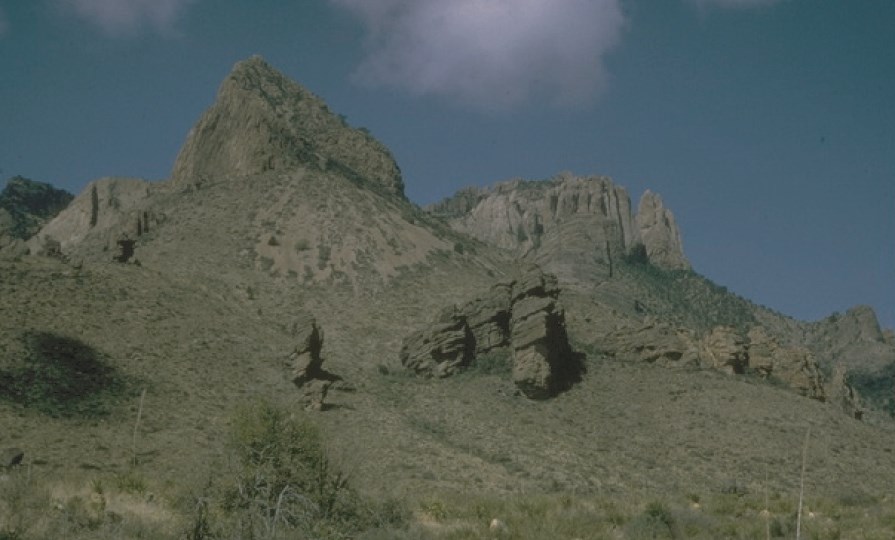
NPS photo.
Brooks Range
Northern Alaska was the site of continental collision that progressed to a stage somewhere between the soft collision seen in the Ouachita and Marathon mountains, and the hard collision observed in the Appalachians and Himalayas. In its prime, well-nigh 100 1000000 years ago, the Brooks Range probably had mountains as high every bit the Alps of Europe. Gates of the Arctic National Park and Preserve reveals mountains much college than those seen in the Appalachians, because the Brooks Range is notwithstanding young—erosion has not worn the landscape downwards quite as much. Other NPS sites farther west in the Brooks Range include Greatcoat Krusenstern National Monument, Kobuk Valley National Park, and Noatak National Preserve.
NPS Sites in Alaska
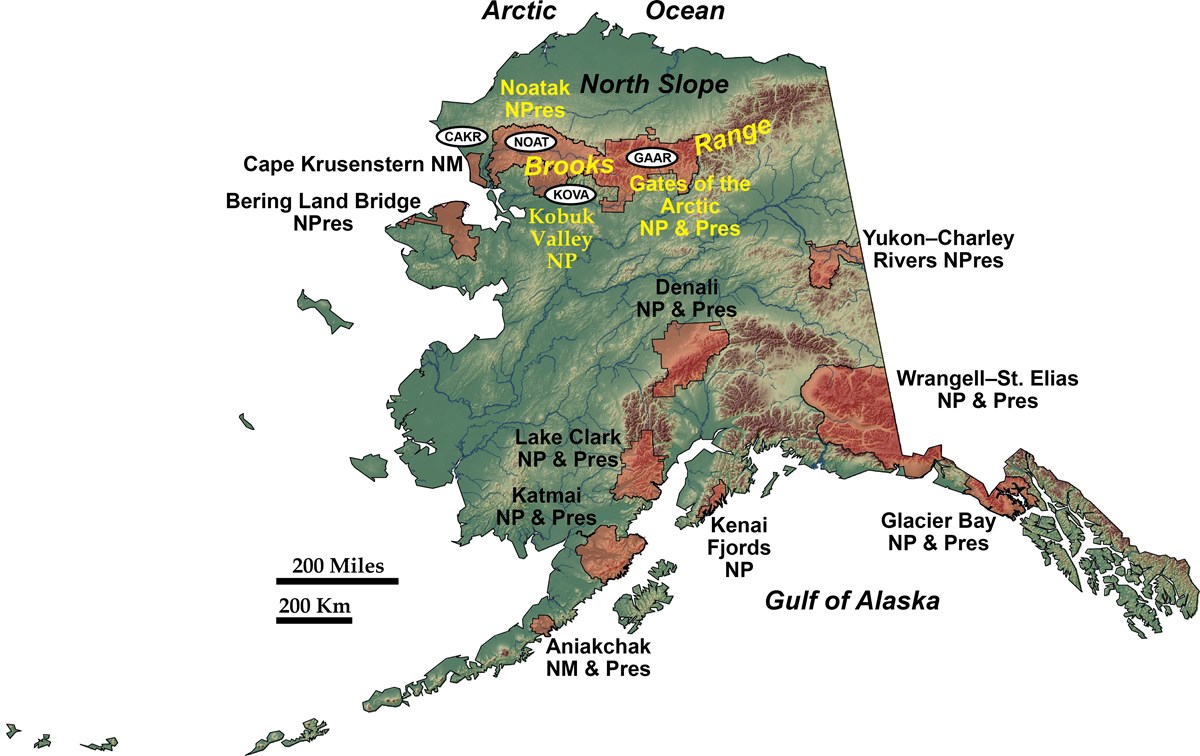
Modified from "Parks and Plates: The Geology of our National Parks, Monuments and Seashores," by Robert J. Lillie, New York, W. Due west. Norton and Company, 298 pp., 2005, www.amazon.com/dp/0134905172.
Tectonic Development of the Brooks Range
200 Million Years Ago
Bounding main separating northern Alaska and a continental fragment begins to close.


150 Million Years Ago
Continents collide but proceed to converge.

120 Million Years Ago
The northern continent extends laterally for more than lx miles (100 kilometers) below northern Alaska, thickening the crust.

100 Million Years Ago
The mountains reach heights similar to those of the modern-day Alps, as the hard crust of northern Alaska breaks and uplifts.

Today
The Chill Body of water opens on the north. Later eroding away up to 10 miles (16 kilometers) of stone, there is nevertheless a small crustal root that maintains mountain heights much greater than those seen today in the Appalachians.
Illustrations in a higher place adjusted from "Crustal structure and kinematic evolution of the Brooks Range, Alaska, from gravity and isostatic considerations," by Jonathon Williams, M. S. Thesis, Oregon State University, 2000.
Gates of the Arctic National Park and Preserve, Alaska
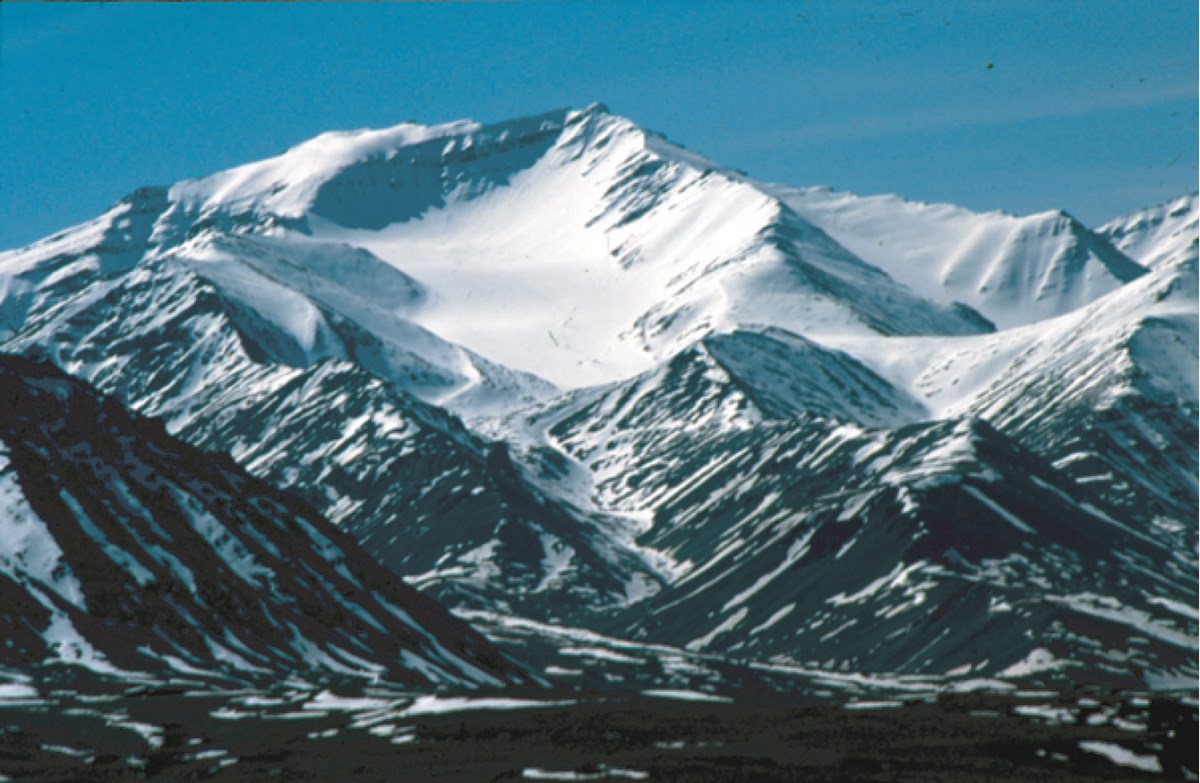
Photograph courtesy of Robert J. Lillie.
Figures Used
Site Index & Credits
Plate Tectonics and Our National Parks (2020)
-
Text and Illustrations by Robert J. Lillie, Emeritus Professor of Geosciences, Oregon Land Academy [E-mail]
-
Produced nether a Cooperative Agreement for earth science education between the National Park Service's Geologic Resources Partition and the American Geosciences Institute.
Source: https://www.nps.gov/subjects/geology/plate-tectonics-collisional-mountain-ranges.htm
0 Response to "What does land to land convergnt boundaries cause?"
Post a Comment